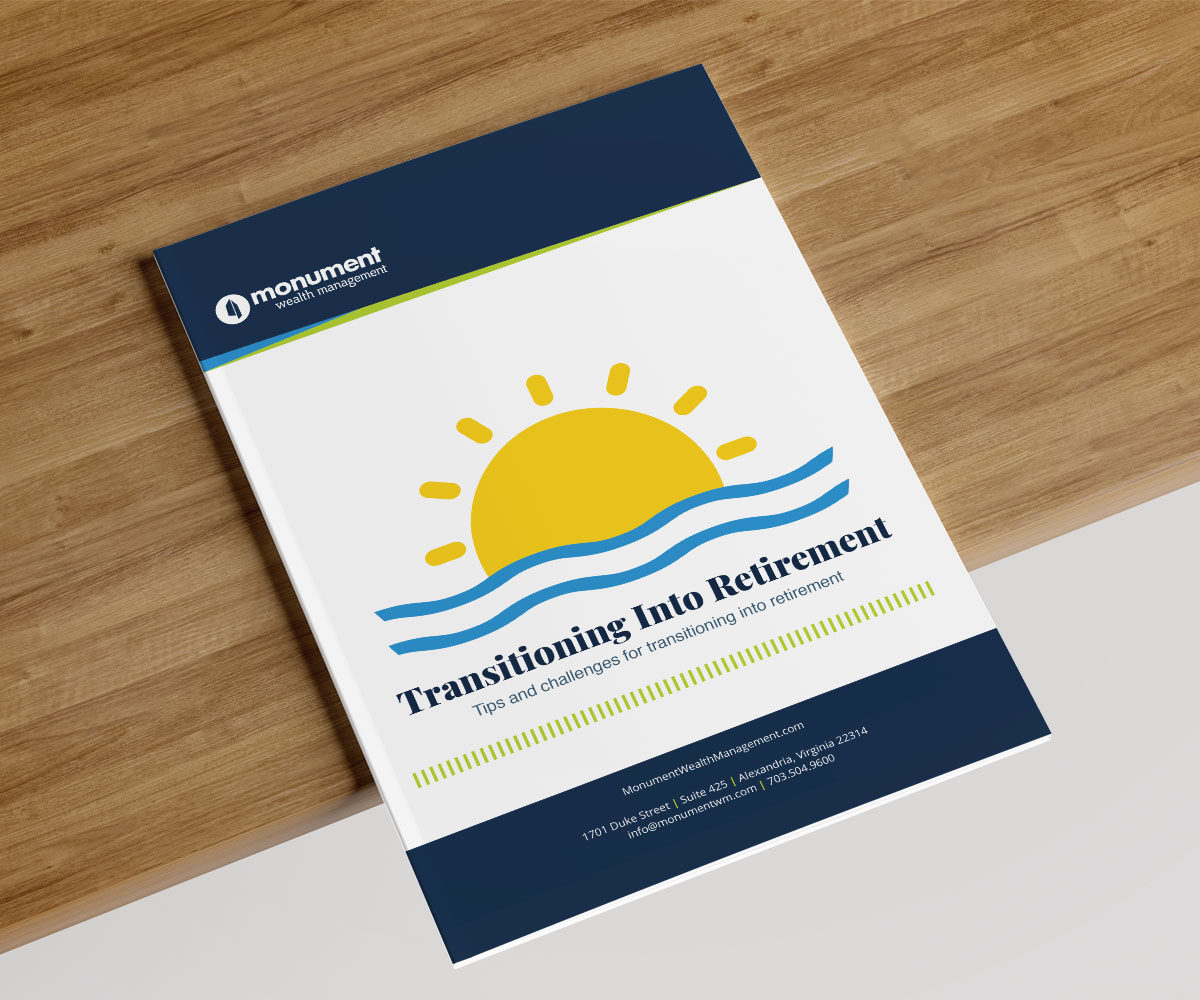Monument Wealth Management Articles
Transitioning Into Retirement

Share on your favorite platform, or by email

Transitioning Into Retirement
Tips and challenges for transitioning into retirement
Recently, we’ve had several clients make the transition from their last job into full-time retirement. The financial industry, as a whole, has not done a great job of providing an effective road map for this momentous change across nearly every facet of one’s life.
However, we’ll take this opportunity to highlight three of the most important challenges that our clients have faced when transitioning into retirement and offer you some ideas to benefit from their experiences.
Read the article on u.s. news & world report here!
First, let’s frame the discussion:
Imagine that after a working life of more than 40 years, sometimes made up of multiple careers, you find yourself at the end of one road—and the beginning of another. In the process, for many people, nearly every part of their daily routine will change.
Whether you are 50 or 80, our experience tells us that you are likely to drastically change the pace at which you operate throughout your life. However, for many of our clients, this change is more a process of substitution rather than a wholesale revision.
In fact, we regularly joke with several of our clients who are no longer working that it is harder to find time for us to meet now that they are retired, given how much they are packing into their now “empty” schedules. Beyond the difficulties of a newly busy social and travel schedule, both to see grandkids and long dreamt of far-off places, there are a series of financial challenges that our clients have run into head-on after they’ve left the workforce.
1. Income Stream in Retirement
The first and most fear-inducing challenge with transitioning into retirement is simple, although significant: How will you replace the income stream of your salary for a time frame that may stretch decades into the future?
Many of our clients have been fortunate enough to have built and eventually sold a successful business. Others have carefully planned and diligently saved to build a substantial pool of assets that they will begin to draw down. In any case, this shift from an “accumulation” mindset to the “distribution” phase creates a great deal of stress and consternation.
For our clients, we approach this issue much like a pension fund manager would: We calculate the future value of the regular payments needed to fund their lifestyle, adjust for expected potential asset growth and inflation, and allocate assets to strategies that seek to produce a steady and low volatility stream of income, while still maintaining enough growth potential to outpace the risk to purchasing power presented by the rising price of the goods and services they enjoy.
Of course, this process also takes into account any additional or supplemental sources of retirement income, such as pension payments or Social Security benefits.
2. Retirement Expenses
The second challenge that our clients have brought to our attention when transitioning into retirement is also fairly simple to express, if somewhat more time consuming to categorize: How will your spending and expense structure change now that you are not working?
Recent studies indicate that many Americans, in the first years after they retire, increase their spending. This subsides after roughly five years and eventually gives way to a reduced level of expenses later on in life. In the course of this discussion, our clients consistently tell us about another process of substitution. For example, while dry cleaning bills may tend to drop off, the costs of having lunch with friends might fill that void. Business travel is often replaced by the adventure of a lifetime heading to places like Antarctica or the Amazon.
In any case, we regularly hear that the tracking and categorization of budget items is as important to a smooth transition as the performance of an investment portfolio. However, for many clients, this is an unpalatable concept. We have had great success using online budgeting tools, which can link directly into the transaction history of credit card and checking accounts to produce a complete and accurate picture of spending in real time. Keeping a watchful eye on where the money goes, especially in the first several months or year after the transition, is an essential exercise.
Studies have repeatedly shown that the two to three years before and the two to three years after the shift from accumulation to distribution present the greatest risk to the longevity of a portfolio-based income stream. Therefore, ensuring that you do not overspend in the early retirement years may have a compounded effect on your success or failure to meet your retirement spending needs.
3. Retirement Taxes
The third challenge of transitioning into retirement that we hear about time and again is how to manage the changes to clients’ income pictures that will affect their tax liability. Many clients have always had taxes withheld from their monthly paychecks in sufficient amounts to cover their expected tax obligations. However, once you begin to draw from retirement plans, or accept an annuitized income stream from a portfolio, that same tax withholding is no longer applied.
The solution to this situation is to make quarterly estimated tax payments. For many of our clients, especially those who had run a business, this process is a familiar one. However, for those who had a more conventional salary, this is a new experience.
We generally recommend setting up a separate tax savings account, linking it to the Federal government’s EFTPS (electronic payments) system, and scheduling quarterly payments based on estimates created in consultation with tax advisers and financial planners. Many states also allow for this type of simple, online estimated tax payment.
Another new experience many retirees will encounter is the required minimum distribution, or RMD, from qualified retirement plan accounts. These distributions are mandated by the government to ensure that tax deferred accounts do eventually produce taxable income. The process starts after the owner attains age 72, and it uses a set formula to calculate the minimum amount that must be withdrawn from IRA or 401(k) accounts, and therefore taxed. This income must be factored into the above processes.
Consult with your financial planner or tax advisers to ensure you meet the requirements each year, or you could face penalties and interest charges.
Transitioning into Retirement: The Bottom Line
Our experience has led us to build easy-to-understand processes to combat the above challenges that our clients who are preparing to retire may face. In each of the above cases, as well as many other situations that the newly retired face, the name of the game needs to be flexibility. Even after a lifetime of hard work and despite the difficulty of change, by focusing on basic solutions, our clients have been able to adjust smoothly.
After all, I’ve read that it only takes 21 days to build a new habit, so try to face these problems head on and look for easy ideas to keep it simple. By thinking ahead and working closely with careful advisers, your chances of deeply enjoying the fruits of your hard work—and your ability to look forward to many long and fulfilling golden years—are greatly increased.

Transitioning Into Retirement
Ready for straightforward, unfiltered opinion and tailored advice for YOUR questions, not everyone else’s?
IMPORTANT DISCLOSURE INFORMATION
Please remember that past performance is no guarantee of future results. Different types of investments involve varying degrees of risk, and there can be no assurance that the future performance of any specific investment, investment strategy, or product (including the investments and/or investment strategies recommended or undertaken by Monument Capital Management, LLC [“Monument”]), or any non-investment related content, made reference to directly or indirectly in this blog will be profitable, equal any corresponding indicated historical performance level(s), be suitable for your portfolio or individual situation, or prove successful. Due to various factors, including changing market conditions and/or applicable laws, the content may no longer be reflective of current opinions or positions. Moreover, you should not assume that any discussion or information contained in this blog serves as the receipt of, or as a substitute for, personalized investment advice from Monument. To the extent that a reader has any questions regarding the applicability of any specific issue discussed above to his/her individual situation, he/she is encouraged to consult with the professional advisor of his/her choosing. No amount of prior experience or success should be construed that a certain level of results or satisfaction will be achieved if Monument is engaged, or continues to be engaged, to provide investment advisory services. Monument is neither a law firm nor a certified public accounting firm and no portion of the blog content should be construed as legal or accounting advice.
A copy of Monument’s current written disclosure Brochure discussing our advisory services and fees is available for review upon request or at www.monumentwealthmanagement.com/disclosures. Please Note: Monument does not make any representations or warranties as to the accuracy, timeliness, suitability, completeness, or relevance of any information prepared by any unaffiliated third party, whether linked to Monument’s website or blog or incorporated herein, and takes no responsibility for any such content. All such information is provided solely for convenience purposes only and all users thereof should be guided accordingly.
Historical performance results for investment indices, benchmarks, and/or categories have been provided for general informational/comparison purposes only, and generally do not reflect the deduction of transaction and/or custodial charges, the deduction of an investment management fee, nor the impact of taxes, the incurrence of which would have the effect of decreasing historical performance results. It should not be assumed that your Monument account holdings correspond directly to any comparative indices or categories. Please Also Note: (1) performance results do not reflect the impact of taxes; (2) comparative benchmarks/indices may be more or less volatile than your Monument accounts; and, (3) a description of each comparative benchmark/index is available upon request.
Please Remember: If you are a Monument client, please contact Monument, in writing, if there are any changes in your personal/financial situation or investment objectives for the purpose of reviewing/evaluating/revising our previous recommendations and/or services, or if you would like to impose, add, or to modify any reasonable restrictions to our investment advisory services. Unless, and until, you notify us, in writing, to the contrary, we shall continue to provide services as we do currently. Please Also Remember to advise us if you have not been receiving account statements (at least quarterly) from the account custodian.